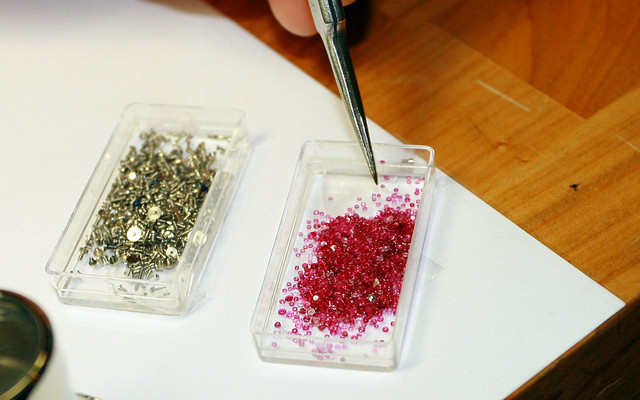Tuesday, December 28, 2010
The Hectometer: William Trubridge's 101m dive
The HECTOMETER freedive from william trubridge on Vimeo.
Sponsored by Suunto, Orca and 100 individual sponsors (one for each meter), William made an epic 101m dive last week in the Bahamas...
Monday, December 20, 2010
Bremont and the Jaguar C-X75
The first Jaguar I ever recall sitting in was a beautiful red XJS: a V12 HE. I was very young, but distinctly remember being incredibly excited at the sight of this shiny, new and extremely sleek beast. I think it was the coolest thing I'd ever seen, and certainly had one of the throatiest roars I'd ever heard, with a lovely purr as it cruised up the A22.
 I remember being excited every time I saw that car - and I still get the odd twinge, even now. On Friday afternoon, while visiting the Berkeley Boutique as a guest of Bremont and ATG Vintage Watches, I suddenly found myself rediscovering my inner nine year old (as the squeals on the accompanying video will testify). The Jaguar C-X75 concept really is the most wonderful thing I've seen an many a year: the curves of its silver flanks; the twin gas turbines visible through the rear window; the red Martin-Baker styled door handles positioned on the seat; the wonderfully techno-retro display; and, of course, the Bremont watch mounted proudly in the console. The clock is still a concept - as is the Jaguar - but is based upon the tried and tested (beyond endurance) MB watches developed with Martin Baker, and the recent pocket watch developed as a bespoke project for the "handmade" edition of Wallpaper* in August.
I remember being excited every time I saw that car - and I still get the odd twinge, even now. On Friday afternoon, while visiting the Berkeley Boutique as a guest of Bremont and ATG Vintage Watches, I suddenly found myself rediscovering my inner nine year old (as the squeals on the accompanying video will testify). The Jaguar C-X75 concept really is the most wonderful thing I've seen an many a year: the curves of its silver flanks; the twin gas turbines visible through the rear window; the red Martin-Baker styled door handles positioned on the seat; the wonderfully techno-retro display; and, of course, the Bremont watch mounted proudly in the console. The clock is still a concept - as is the Jaguar - but is based upon the tried and tested (beyond endurance) MB watches developed with Martin Baker, and the recent pocket watch developed as a bespoke project for the "handmade" edition of Wallpaper* in August. 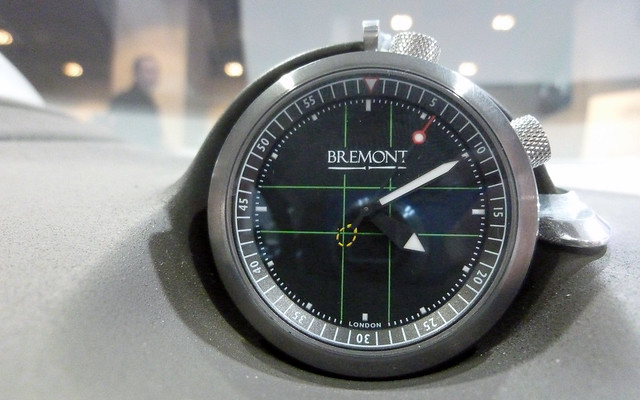 A beautifully-milled back, echoing the shape of the blades in the gas turbines, allows the clock to be mounted both on the dash and as a desk clock. Should the design be taken into production, Bremont hopes to produce a device to translate the energy from the braking / acceleration of the car into the rotary movement required to power the Soprod-modified automatic movement. Bremont are also looking at the possibility of installing a watch winder for periods of inactivity.
A beautifully-milled back, echoing the shape of the blades in the gas turbines, allows the clock to be mounted both on the dash and as a desk clock. Should the design be taken into production, Bremont hopes to produce a device to translate the energy from the braking / acceleration of the car into the rotary movement required to power the Soprod-modified automatic movement. Bremont are also looking at the possibility of installing a watch winder for periods of inactivity. 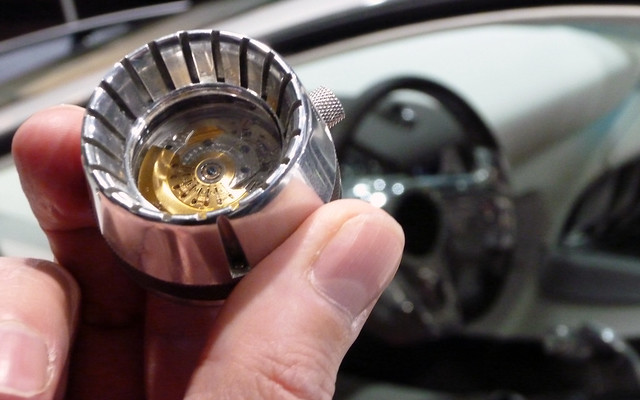 The car itself is studded with wonderful driver-centric design touches - some of which recall Jaguars of yesteryear (e.g. the E-Type digital dash or the flowing lines of the acheingly beautiful XJ-220), while others are pure Tron. For example, the speakers in each of the doors are concepts designed by Bowers & Wilkins. Each is backlit in a soothing blue, and contains a series on one watt "nano speakers" rather than the traditional woofer / tweeter configuration. The door release is situated between the legs of the driver, and draws on the red warning triangles used by Martin Baker in their ejector seats. The start / stop levers are above the driver's head, and, rather than have an adjustable seat, the entire console (including pedals) moves towards the driver, while strips illuminate around the seats, drawing you into the console.
The car itself is studded with wonderful driver-centric design touches - some of which recall Jaguars of yesteryear (e.g. the E-Type digital dash or the flowing lines of the acheingly beautiful XJ-220), while others are pure Tron. For example, the speakers in each of the doors are concepts designed by Bowers & Wilkins. Each is backlit in a soothing blue, and contains a series on one watt "nano speakers" rather than the traditional woofer / tweeter configuration. The door release is situated between the legs of the driver, and draws on the red warning triangles used by Martin Baker in their ejector seats. The start / stop levers are above the driver's head, and, rather than have an adjustable seat, the entire console (including pedals) moves towards the driver, while strips illuminate around the seats, drawing you into the console. The video shows the startup, from a track day at Le Mans. After a quick flying lap around the curves, the Jag checks its aerodynamics and then begins to test the twin gas turbines, before coming to rest with some lovely retro E-Type dials. It's hard not be excited by this concept from Jaguar, and I do hope that it makes it into production. The expected performance is staggering: 0-62 in 3.4 seconds and a top speed of 204mph, thanks to the 4 x 195hp electric motors. Not bad for an electric car!
The C-X75 is available for viewing at The Berkeley Boutique until Friday 24th December and from Tuesday 28th to Friday 31st December 2010. More photos can be found here.
Wednesday, December 15, 2010
Is this the first ladies' dive watch?
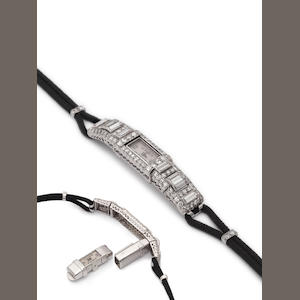 At Bonhams today, sometime this afternoon, Lot 324 will come under the hammer. Most of you may have left the building by then, as you'll probably be largely following the sale of the excellent collection of 60's, 70's and very early 80s Heuers from the Haslinger Collection. However, if you do stick around, you might see something rather special.
At Bonhams today, sometime this afternoon, Lot 324 will come under the hammer. Most of you may have left the building by then, as you'll probably be largely following the sale of the excellent collection of 60's, 70's and very early 80s Heuers from the Haslinger Collection. However, if you do stick around, you might see something rather special.
Lot 324 is described as "Swiss. A fine and very rare platinum and diamond set wristwatch with an early form of sealed case design 1920's." It boasts a jewelled lever movement with cut and compensated balance, silvered dial with Arabic numerals and blued steel hands and a platinum hinged case. The movement slides out from within the filigree platinum case to reveal a very slim rectangular winder (just visible in the photo). Incredibly, the entire watch (including the diamond-covered*, articulated case) is no wider than 10mm. Just think about that for a moment. The movement inside is approximately 8 mm across. Astounding!
Now, the reason that this particular watch is very unusual and of such interest to me (apart from the micro-mechanical movement), is that it features a very early form of waterproofing**. In many respects, it is similar to the Omega Marine case design which was patented as No.146.310 on March 10, 1930***, a few years after the Rolex "Oyster" case and screw-down crown was patented (1927). The movement is kept dry by being cased twice - once in the movement case, and then again in the actual watch case.
The "Marine" cases were designed to keep marine clocks, and indeed certain wristwatches, dry and were apparently designed for use by the Navy and, some have argued, could be described as the world's first "dive watches". In 1936 and 1937, a series of dives took similarly-cased watches to between 70m and 135m. The famous French naval diver and inventor Yves le Prieur (1885 to 1963), who invented a hand-controlled self-contained underwater breathing apparatus back in 1926, is said to have owned one of these Marine Case watches. That this watch is dated closer to 1926 than 1937 makes it very interesting indeed. Is this a pre-Patent model?
So, what we have here is, technically, one of the first ladies' "dive watches" ever to be made. Or perhaps not. But whatever it is, I hope its next owner wears it in very, very good health.
the #watchnerd
*The diamonds are wonderfully set in platinum, with large 10mm baguettes running horizontally across the articulated case. It's a beautiful piece of jewellery in its own right, which may go some way to explaining the £8,000 - £10,000 estimate...!
*The diamonds are wonderfully set in platinum, with large 10mm baguettes running horizontally across the articulated case. It's a beautiful piece of jewellery in its own right, which may go some way to explaining the £8,000 - £10,000 estimate...!
**The early history of waterproof watches is fascinating, and while Peret and Perregaux's (later, Hans Wilsdorf's) design for the screw-down crown was the "missing link" between the Rolex Watch Company's Submarine and the Rolex Oyster case, it's probably not one that had a massive bearing on the design of another of my favourite dive watches, the Russian Zlatoust 191yc. The latter appears to have more in common with the Submarine (or perhaps the Omega Marine) than the Oyster, relying (as it does) on a large, robust, steel and glass coffin to surround the movement. Even the crown is similarly shrouded (no matter how may Zlatoust watches I see, I'm remain amazed at how flimsy their stems / winders are). The Marine suffered from the same (or at least similar) failings as the Submarine / Marine - you had to remove the watch from the shroud to set / wind the mechanism. Arguably, Harwood came up with a better design in 1923/4 and could (perhaps) be afforded a similar honour. I'm not sure what contact there was between Harwood and Wilsdorf, but one assumes the latter was aware of the former's '24 patent - although, given the later *disagreement* between them which resulted finally in a full Rolex apology, I doubt Wilsdorf would have readily admitted any knowledge. For me, it's a fine example of design evolution and the effect of geography; the Zlatoust, being geographically, politically and ideologically separate from Switzerland appears to have continued down a evolutionary cul-de-sac. While it might be a dead end, I find it no less interesting.
** *see the Omega CK 679 wrist watch
Saturday, December 11, 2010
Mid-Dive Table Mediocrity, Part 2
The past ten years have seen a steady increasing number of companies that have released dive watches into the same pool. Many have sunk. Some still swim, buoyed on by the membership of various watch fora. The history of these watches goes back almost a decade to the first of the “microbrew” dive watches – the English-designed, German-built Dreadnought from Precista. Whilst oft-imitated, this watch has rarely been bettered, certainly in terms of value for money. It offered 2000m WR, excellent time-keeping (a regulated ETA 2892), rugged good looks and a little bit of scarcity value (it was a Limited Edition of 200). Mint copies now trade hands for four-to-five times their original value.
Since then, literally dozens of such watches have sprung up, form the similarly-cased Kenzo Nautilus, to the rash of Submariner-a-likes produced in 2009. These latter watches all appear to utilise the same Chinese-milled case, and are WR to 2000m. Now, into this relatively deep pool of watch-sellers, plunges a newcomer - Ril watches.
Designed in London and manufactured in China, Ril Concept's new “Scuba” model is powered by a Japanese automatic movement (no word yet on whether this is a Miyota). The watch will be presented in a luxurious case, and all watches are supplied with both a regimental G10 NATO strap and a solid stainless-steel adjustable bracelet. Ril’s creators (Nathan Halfon and Robert Gilbert) appear to have built a 38mm, unisex, Rolex Submariner-style watch, with a sterile dial. But with a water resistance of only 30m (100ft). Hey ho. One the plus side, the crown is unusually large, and echoes the vintage models from which this design has been borrowed.
Since then, literally dozens of such watches have sprung up, form the similarly-cased Kenzo Nautilus, to the rash of Submariner-a-likes produced in 2009. These latter watches all appear to utilise the same Chinese-milled case, and are WR to 2000m. Now, into this relatively deep pool of watch-sellers, plunges a newcomer - Ril watches.
Designed in London and manufactured in China, Ril Concept's new “Scuba” model is powered by a Japanese automatic movement (no word yet on whether this is a Miyota). The watch will be presented in a luxurious case, and all watches are supplied with both a regimental G10 NATO strap and a solid stainless-steel adjustable bracelet. Ril’s creators (Nathan Halfon and Robert Gilbert) appear to have built a 38mm, unisex, Rolex Submariner-style watch, with a sterile dial. But with a water resistance of only 30m (100ft). Hey ho. One the plus side, the crown is unusually large, and echoes the vintage models from which this design has been borrowed.
“Its dial is unadorned, showing no brand, for Ril Concept believes that the Ril Watch Scuba should say but one thing: “It belongs to you.” Only a Ril Watch Scuba’s owner will know the brand, its name relegated to the case-back.”
While I applaud the concept (and Ril is very much a “concept”, with clothes, homeware and a club coming in 2011), I can’t help thinking that there’s not much separating the Ril from the $1000 herd. Nor indeed from a handful of similar designs in far lower price brackets. The hands look relatively normal, the dial pedestrian. The lume appears to offer nothing over the now-standard SuperLuminova®. In short, I find the launch of Ril a little underwhelming.
This feeling is exacerbated by the rather strange one year warranty offered with each watch: “During this period, any errors due to manufacturing defects or the bad phenomenon made by non-artificial factors will be repaired free of charge. This will make you feel more satisfaction with our service. Special instruction: case, band and dial are not included in the warranty.” I told you it was odd…
Perhaps I have missed the point; this is a watch "concept" after all. And any newcomer who positions itself in direct opposition to Patek Philippe (however playfully) must have a plan: "You actually own a Ril Watch. You do not need to wait for the next generation." But I remain unsure as to what, exactly, that plan is. Perhaps this watch will be the key to Ril’s next venture? A secret sign to the cognoscenti? Who knows?
As an aside - I actually do rather like the "de-badged" offering: one of the first watches ever given to me was a small, plain, off-white quartz watch from GRUS - another brand that feels that a logo on the dial detracts from the design aesthetic.
As an aside - I actually do rather like the "de-badged" offering: one of the first watches ever given to me was a small, plain, off-white quartz watch from GRUS - another brand that feels that a logo on the dial detracts from the design aesthetic.
One final point. I note that Ril are giving $6 per watch sold to Shelter, the bad housing and homeless charity. This is surely to be praised.
Ril Watches are available on-line now, at £599 or $999.
Sunday, December 05, 2010
A Peter Speake-Marin GTG in London
Firstly, a confession: I do not own one of Peter Speake-Marin's watches. I should dearly like to, and certainly aspire to own one, but at present, my Speake-Marin desires are being vicariously lived though Peter's excellent A Passion for Watchmaking and those watches I see posted on Twitter, forums, etc. To be invited (thanks to the Sydney Tarts) to attend the first ever London PSM GTG was therefore something of an honour.
On Friday evening, I rushed out of work just after five, jumped on the tube down to Oxford Circus and walked the five or so minutes to Albermarle Street. I'd not met Peter before - this was his first GTG in London, after all. And given the price of some of his pieces, I wasn't sure whether the room would be full of collectors, watch nerds or something else completely. Turns out the he'd booked the back room of a small Italian restaurant called Dolada. Nice venue. Quiet. Great staff. There were already about ten people there by the time I arrived, including two names I recognised from the ACHI PuristS forum - Greg D and Mo - James Gurney (editor of QPMagazine and organiser of the incredibly successful SalonQP 2010 in London the previous month), a couple of people I recognised from Somlo, including George and his wife, who I'd last met at the Olympia Fine Arts Fair. But no Peter.
Greg explained the Peter was approximately four hours behind due to bad weather into Gatwick; I must admit I was incredibly disappointed. I chatted with Mo and Greg for a while, ogled a lovely gold snake calendar Piccadilly (which turned out to be Peter's own watch), and an incredible 1in20 perpetual calendar, while drinking some excellent Prosecco. Greg made a call and confirmed that Peter had taken off and would be jumping in a cab when he arrived at snowy Gatwick.
I had another appointment, so said my goodbyes, popped off the Apple store to get a replacement phone. By the time I got back over an hour and a half later, there were only four people left. They'd moved to a table in the centre of the restaurant but there was still no sign of Peter. Greg very kindly asked me to join their table, so I ordered a glass of wine and spent lovely hour chatting about pens, chef's knifes, food, top end audio and Japanese studio ceramics!
And then Peter arrived. He was instantly recognisable and wearing the trademark scarf. He looked absolutely frazzled. He'd had a nightmare with Swiss Customs, had been delayed nine hours in total and was pretty much dead on his feet. He grabbed a beer, sat down next to me and whipped off his Thalassa!
 |
| The Speake-Marin Marin-2 Thalassa |
A brief interlude: the Marin-2 Thalassa is the latest watch to be designed and built by Peter. It contains the in-house SM2m manual wind movement, a beautifully blued hand set, framed by a blue outer dial with cut-out roman numerals and the most incredible running seconds, based on Peter's trademark vintage topping tool design.
 |
| The SM2m movement |
It really is an absolutely lovely piece. The white gold case is weighty, solid but also perfect on the wrist. The German silver bridges, so visible through the cut-out dial, have a warmth to them which is rarely seen in other metals. The movement, visible through the caseback, is a series of off-centre circles, with multiple layers, a highly three-dimensional appearance, and the lovely double swan-neck regulator and trademark large jewel framing the central mechanism.
Thank you Peter, for braving the snow, ice and Swiss customs, and thank you for bringing with you the Thalassa. I have a new aspirational piece, that's for sure.
Thursday, December 02, 2010
Inside SalonQP 2: Jaeger-LeCoultre's jewels...
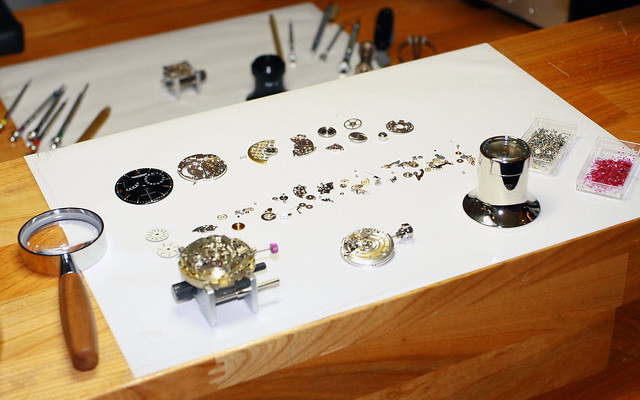 Jaeger-LeCoultre were showing strongly at SalonQP 2010, with the new Master Compressor Extreme Lab 2 GMT (Tribute to Geophysic). But alongside that impressive piece, was a gentleman, a desk, and a great deal of very, very small jewels. I was offered a loupe and a guided tour of one of JLC's more mainstream automatic movement - a 938 or similar movement by the looks of the dial on display. All 273 parts! Loupe in hand (well, in eye) I squinted at jewels, cogs, screws, and of course, the more exciting parts of the watch, such as the various bridges, escapement parts and the rotor. But it was the jewels to which I kept returning.
Jaeger-LeCoultre were showing strongly at SalonQP 2010, with the new Master Compressor Extreme Lab 2 GMT (Tribute to Geophysic). But alongside that impressive piece, was a gentleman, a desk, and a great deal of very, very small jewels. I was offered a loupe and a guided tour of one of JLC's more mainstream automatic movement - a 938 or similar movement by the looks of the dial on display. All 273 parts! Loupe in hand (well, in eye) I squinted at jewels, cogs, screws, and of course, the more exciting parts of the watch, such as the various bridges, escapement parts and the rotor. But it was the jewels to which I kept returning.
There's a photo* in Peter Speake-Marin's A Passion for Watchmaking that he also posted as a teaser on Twitter: it's of a pile of jewels. Sparkling, pink and utterly beautiful. I'd not seen so many in one place before, and it started something of a minor fascination with these strange, synthetic rubies. The jewels for any watch largely have two purposes: to reduce friction and act as a reservoir for lubricants. To see so many on the JLC stand was just as remarkable.
A finished movement was also on display - without the rotor and it was lovely to spend a few minutes talking about the finer side of horology - actually making a watch. I learnt, for example, that it only takes a couple of hours to take one of these (standard movement) JLCs apart, clean it and put it all together. My host seemed to suggest that there's really only one way all 273 parts can fit together - although I'm not sure it'd be so easy for anyone else. Altogether a fascinating time spent talking about a fascinating brand.
*page 166 if you have a copy - and if you don't, shame on you
Subscribe to:
Posts (Atom)


